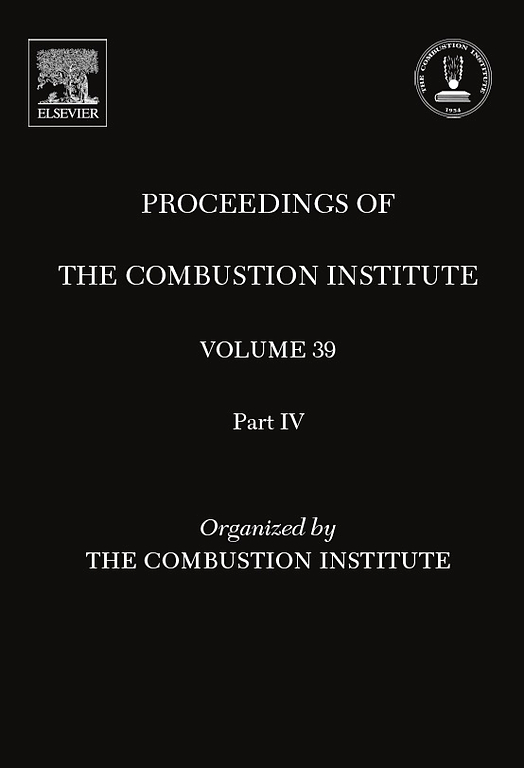纳秒重复脉冲放电对湍流预混合火焰的稳定极限
IF 5.2
2区 工程技术
Q2 ENERGY & FUELS
引用次数: 0
摘要
研究了在高速湍流预混合甲烷-空气火焰中使用纳秒重复脉冲(NRP)等离子体放电稳定火焰的机制,重点是贫化熄灭极限。与大多数将 NRP 放电作为传统稳定器辅助手段的现有研究不同,这里没有使用其他火焰保持方法。高速(10 kHz)OH* 化学发光显示,等离子体放电产生的单个 OH* 袋在足够高的频率下合并在一起,形成连续的火焰片。将放电重复频率从 5 kHz 提高到 10 kHz 可以提高火焰的稳定性,但当频率提高到 10 kHz 以上时,火焰结构和稳定性没有发生变化。在所研究的范围内,等离子体能级的变化对火焰结构的影响很小。在不同流速、等效比、放电频率和能量水平下,对贫化熄灭极限进行了量化。结果表明,熄灭等效比与流速的趋势与传统的崖体稳定火焰相似,在某些运行条件下,纯等离子体稳定火焰也同样有效。有人试图用传统的达姆克勒数 Da 来关联稳定极限,但由于 Da 表达式中存在一个特征焰座长度尺度,因此效果并不理想。有人提出了一个修改后的 Da,以考虑火花频率效应,但也没有成功。相比之下,当使用临界卡尔洛维茨数时,熄灭数据的传播范围较小,因此提供了一种将现有数据推断到其他条件的方法。实验证明,NRP 放电可用作高速湍流预混合火焰的另一种稳定方法。本文章由计算机程序翻译,如有差异,请以英文原文为准。
Stabilisation limits of turbulent premixed flames by nanosecond repetitively pulsed discharges
The mechanism of flame stabilisation using nanosecond repetitively pulsed (NRP) plasma discharges in a turbulent, premixed methane–air flame at high velocities was investigated, focusing on the lean extinction limits. In contrast to the majority of the existing studies that considered NRP discharges as an assistance to conventional stabilisers, here, no other flame-holding method is used. High-speed (10 kHz) OH* chemiluminescence showed that the plasma discharges produce individual OH*-pockets that merge together at a high enough frequency to form a continuous flame sheet. Increasing the discharge repetition frequency from 5 kHz to 10 kHz improves flame stability, but no change in flame structure and stability was observed when the frequency was increased beyond 10 kHz. Change in the plasma energy level in the range studied had little effect on the flame structure. The lean extinction limit was quantified at various flow velocities, equivalence ratios, discharge frequencies and energy levels. It was observed that the trend of the extinction equivalence ratio with bulk velocity was similar to that of a conventional bluff body stabilised flame and that plasma-only stabilised flame was equally effective at certain operating conditions. An effort to correlate the stabilisation limits by a conventional Damköhler number Da was made but was not satisfactory due to the presence of a characteristic flameholder lengthscale present in the Da expression. A modified Da was proposed to take the spark frequency effects into account, but this was not successful either. In contrast, the spread of the extinction data was smaller when a critical Karlovitz number was used, hence offering a way to extrapolate the present data to other conditions. The experiments demonstrate that NRP discharges can be used as an alternative stabilisation method for high-speed turbulent premixed flames.
求助全文
通过发布文献求助,成功后即可免费获取论文全文。
去求助
来源期刊

Proceedings of the Combustion Institute
工程技术-工程:化工
CiteScore
7.00
自引率
0.00%
发文量
420
审稿时长
3.0 months
期刊介绍:
The Proceedings of the Combustion Institute contains forefront contributions in fundamentals and applications of combustion science. For more than 50 years, the Combustion Institute has served as the peak international society for dissemination of scientific and technical research in the combustion field. In addition to author submissions, the Proceedings of the Combustion Institute includes the Institute''s prestigious invited strategic and topical reviews that represent indispensable resources for emergent research in the field. All papers are subjected to rigorous peer review.
Research papers and invited topical reviews; Reaction Kinetics; Soot, PAH, and other large molecules; Diagnostics; Laminar Flames; Turbulent Flames; Heterogeneous Combustion; Spray and Droplet Combustion; Detonations, Explosions & Supersonic Combustion; Fire Research; Stationary Combustion Systems; IC Engine and Gas Turbine Combustion; New Technology Concepts
The electronic version of Proceedings of the Combustion Institute contains supplemental material such as reaction mechanisms, illustrating movies, and other data.
 求助内容:
求助内容: 应助结果提醒方式:
应助结果提醒方式:


